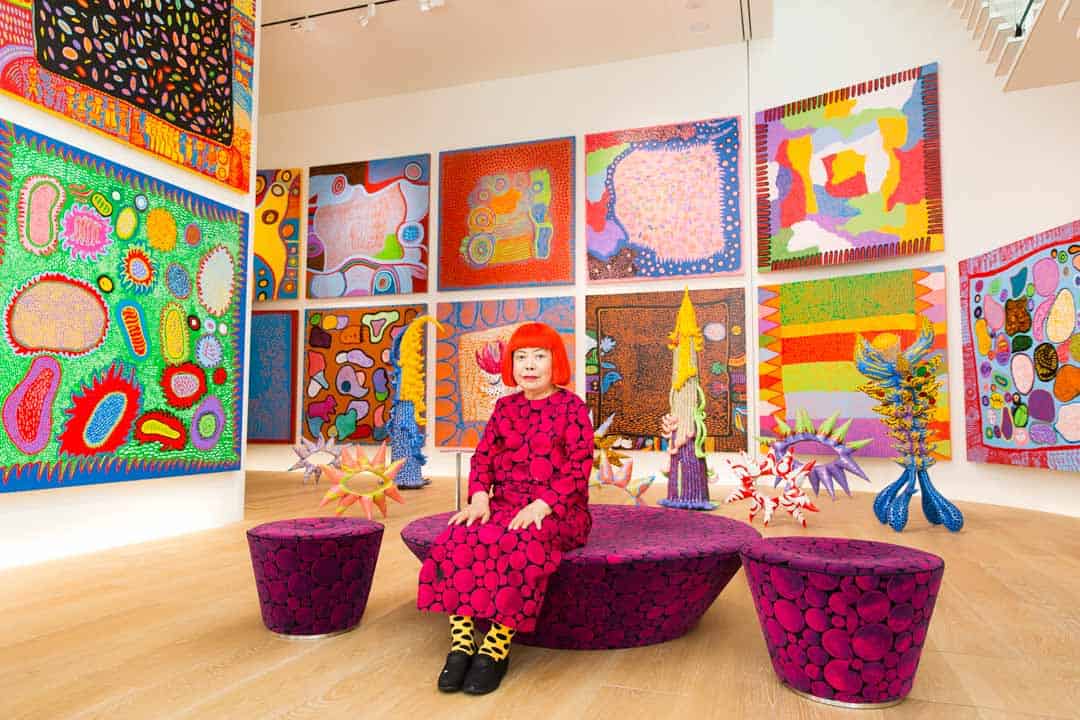If you’ve been commuting in Toronto lately, you’ve likely seen minimalist advertisements around the city featuring mostly blank canvases covered with red polka dots. These vibrant designs, which also cover streetcars and construction sites, advertise the Yayoi Kusama: Infinity Mirrors art exhibition, which comes to the Art Gallery of Ontario (AGO) this spring from March 3 to May 7. It is the exhibit’s only Canadian stop on a two-year North American tour.
Infinity Mirrors is a retrospective on acclaimed Japanese artist Yayoi Kusama, and it features six of her immersive and participatory art pieces. The pieces on display were all created between 1965 and 2016, and they exist in confined rooms meant to accommodate only two to three people at a time, in order to ensure a more private experience of the work for the individual.
At 88 years old, Kusama is experiencing newfound popularity. Her work is now reaching peak levels of adoration and respect, as her retrospectives have sold out around the world. Though she has been creating art since the late 1950s and has worked in similar circles as other avant-garde artists like Andy Warhol and Allan Kaprow, she has never been as much of a household name as she has been in the 21st century.
The works comprising the exhibit are pieces from the 1960s, 1990s, and 2000s that feel timeless and are meant to evoke feelings of being lost in infinity, making them perfectly suited to a retrospective. The pieces invite you to experience a deeply personal exploration of yourself as your eyes wander through rooms filled with countless images of Kusama’s patterned sculptures or seas of LED lights aglow in the mirrored walls. The rooms’ evocative titles, like “Aftermath of Obliteration and Eternity” and “The Souls of Millions of Light Years Away,” pair well with their visual accompaniments.

Artist Yayoi Kusama sits submerged in her thought-provoking exhibitionist artwork. PHOTO COURTESY OF YAYOI KUSAMA
Since 1975, Kusama has spent the majority of her life in a Japanese mental hospital that she voluntarily checked herself into on the advice of her psychiatrist, and she has created her art in a studio near the hospital. Her work creates visual representations of the audio-visual hallucinations she suffers from.
“My artwork is an expression of my life, particularly of my mental disease,” said Kusama in an 1999 interview with BOMB magazine. “I translate the hallucinations and obsessional images that plague me into sculptures and paintings. All my works in pastels are the products of obsessional neurosis and are therefore inextricably connected to my disease.”
Kusama’s growth in popularity since the exhibit started touring in 2017 is likely due in part to the heavy advertisement of her work that social media permits. An experience like Infinity Mirrors, one that is both deeply personal but also highly exclusive due to its limited availability, is the kind of event that takes over social media feeds worldwide.
Her mirrored rooms benefit greatly from daily documentation — and the selfie specifically — as sharing their images allows audiences around the globe a glimpse into Kusama’s world. The AGO has even encouraged sharing selfies taken in the mirrored rooms with #InfiniteKusama.
While Kusama has been creating these experimental and deeply participatory works for decades, her art’s themes of infinity, contemplation of the self, and the mystery of the afterlife ring strong and true now more than ever. Her art represents both a complement to our involved digital age and a moment in time that can exist completely apart.
Whether one chooses to document their short time spent in the Infinity Mirrors exhibit or not, the effect these six rooms will have on their audience will be sure to bring us all closer to Kusama’s mind and vision, as well our own individual perceptions of self.
Obtaining tickets for the exhibits has already become notoriously difficult, with tens of thousands of tickets selling out each time that the AGO releases more. Understanding the demand, the AGO website has an 11-part FAQ on how to better your chances of getting tickets to the exhibit, as well as separate sections explaining the importance of arriving on time and how long a guest will have in each Infinity Room.
The long queues and exhaustive planning necessary may not seem enticing, but the gallery has never before had such a popular exhibit, where demand greatly exceeds the number of tickets and available time slots. The next batch of tickets for Infinity Mirrors goes on sale on March 6 at 10:00 am.


